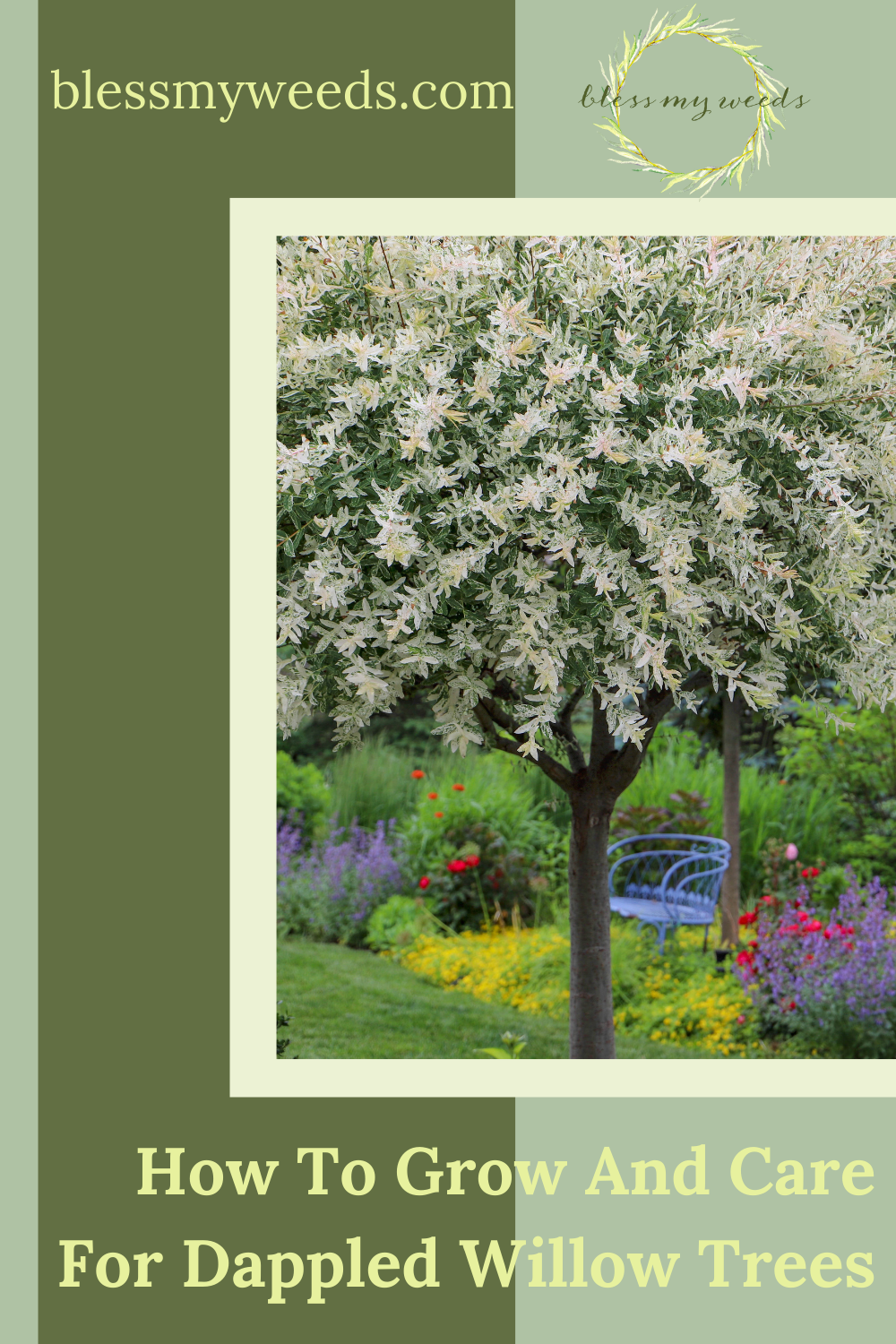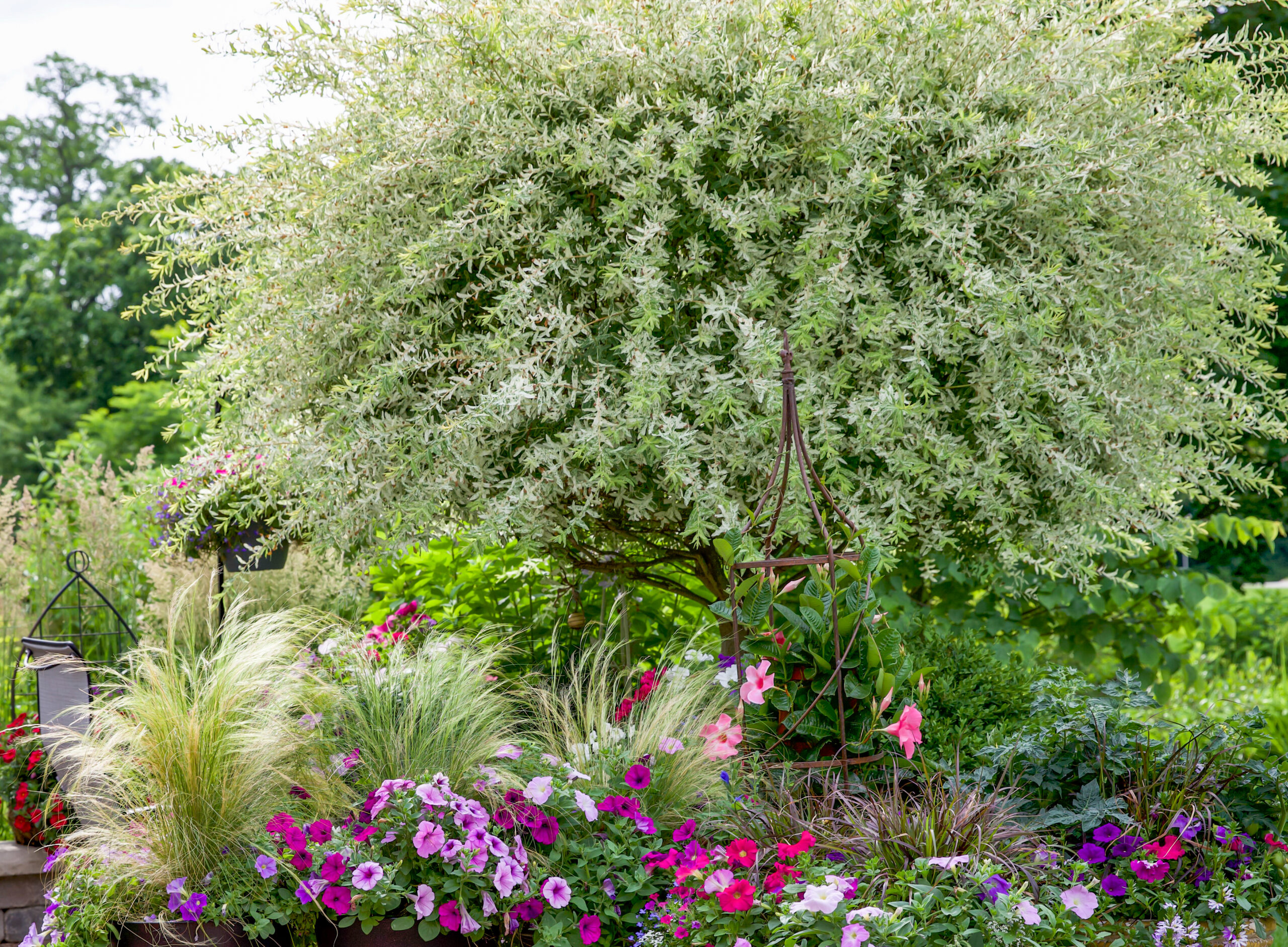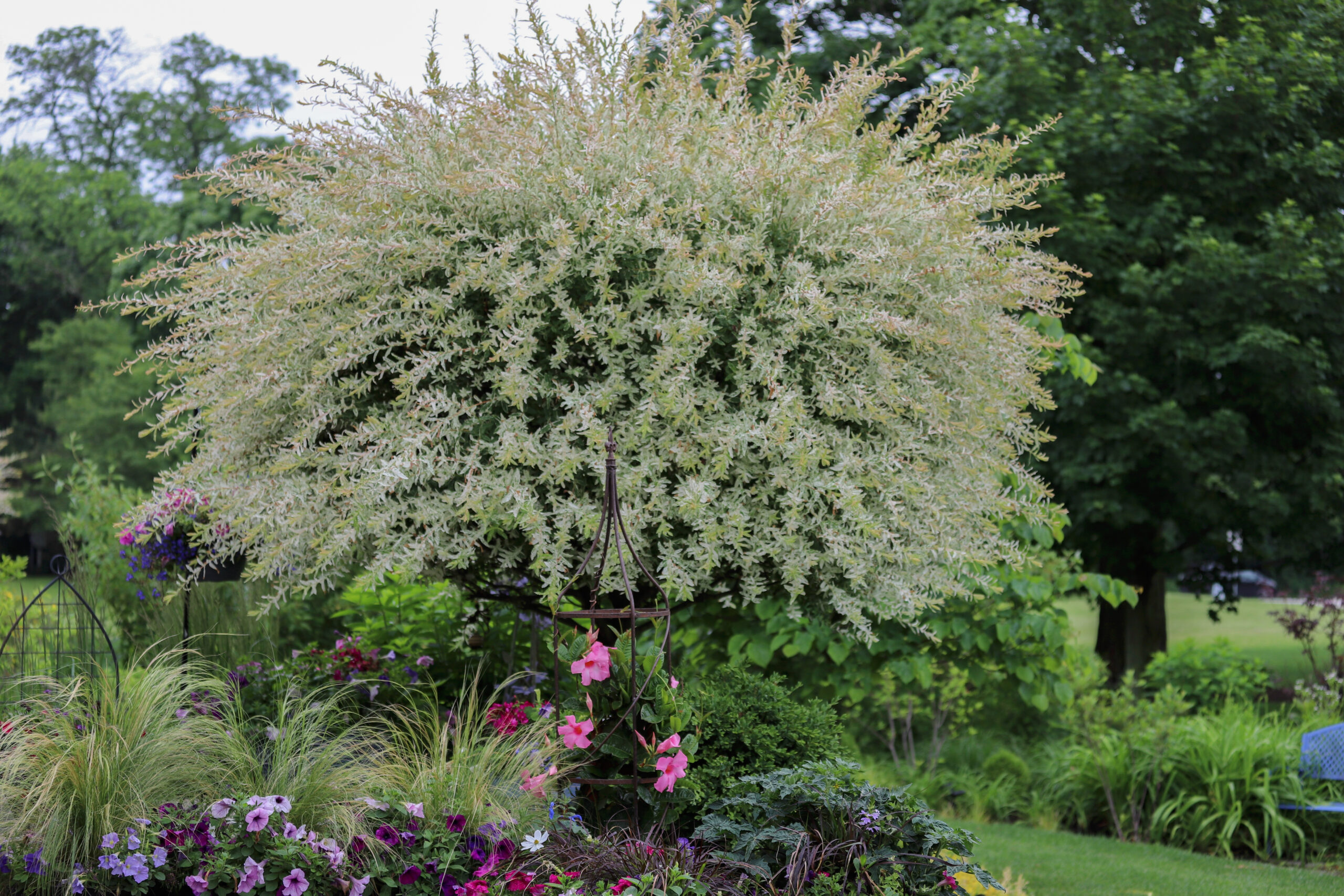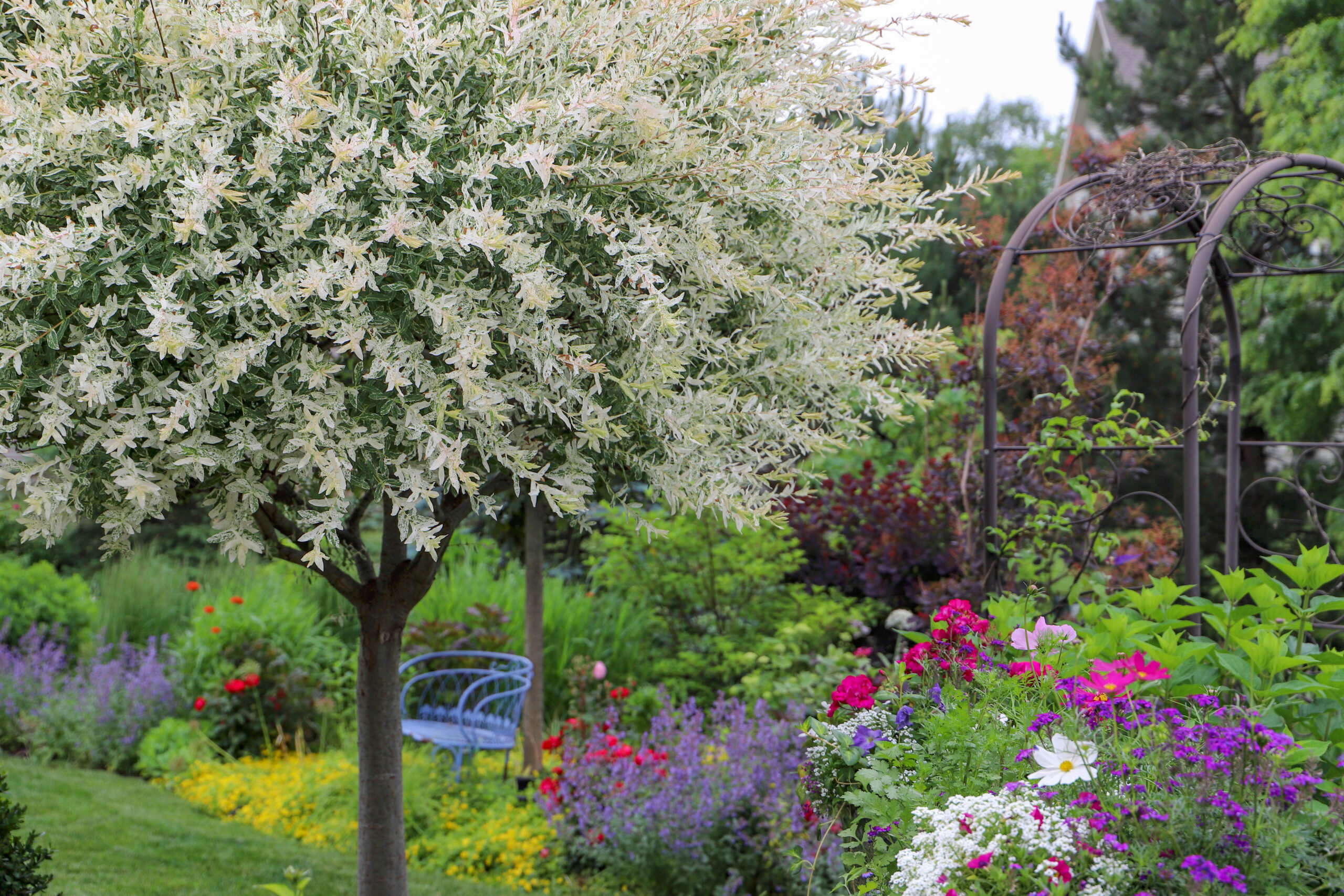The dappled willow tree has earned a lot of fame in the last few years. For the longest of time, most information about this plant family was either untrue or unknown. While it was a rare herb to find, there had been many speculations about the origin of this tree. However, we now know that there are about 300 species of herbs in the willow family. These herbs are widely famous in home landscapes, where you can plant them, tend them, and let them flourish under your watch.

Dappled Willow Tree – Popular Among Home Gardeners
The dappled willow tree has numerous names. Different people around the globe recognize this shrub from different names. Some of them are familiar with Hakuro-Nishiki, while others might call it Albo-Maculata. Some might recognize it as Albomarginata, while others market it as Fuiji Koreangi.
The dappled willow tree has a reputation for being the smallest member of the Willow family. You can also consider it has a large shrub, famous for its colorful leaves and appealing exterior. People use variegated dappled willows in abundance, one of the many reasons for its overall popularity.
Dappled Willow Tree – Breakdown of the Plant

Dappled willow trees are unique. They are different than other trees because of the presence of colorful leaves. Obviously, a tree requires time to become a tree. Initially, it is just a small plant, which ultimately develops, procuring roots, stems, and leaves. The same goes with a dappled willow tree.
Let’s break it down into different parts and see how it emerges as a tree.
Dappled willow tree is beautiful foliage that starts to develop during the spring season. Early spring gives rise to pendent-shaped delicate catkins, yellow in color. These catkins are unique because of their unusual coloring and delicate sizing. As the season triumphs, the leaves start turning into a baby-pink shade, looking incredible as they thrive under the weather.
As the plant reaches its mature age, it starts adapting a dappled, spotted look, which means it embraces its variegated state of white and green. The leaves stay as delicate as they have ever been; however, they grow in size and reach up to 4 inches long.
These long leaves create an illusion of a whirlwind romance as they flaunt their colors, dancing through the breeze. You can see every color distinctively, which can be quite a wonder. These leaves are the sole reason for the popularity of this graceful member of the willow family – a dappled willow tree.
Now that we have covered the exceptional properties of leaves, let’s explore the incredulous beauty of the tree’s unique stems.
Dappled willow tree tends to flourish during spring. As the weather turns cold, these trees lose their usual vibrancy. However, the stems of this tree turn red, maintaining the colorful appearance of the landscape. If you want to achieve a blood-red look, pruning is the way to go. This process will let new leaves grow, keeping the plant alive while creating a redder look for the stems.
What Happens When the Willow Shrubs Attain the Tree Form?
Dappled willow trees are ideal for Northern and Mid-western gardens. This is because you can see the best foliage hues emerging in cooler summer climates. You can find the colorful appearance, the beautiful exterior, and the creative outlook of this plant in places with cooler summer weather.
When willow shrubs attain the tree form, they become strong with an upright willow trunk. These trunks are compatible with the delicacy of the plant, maintaining a strong exterior simultaneously. Therefore, dappled willow trees are famous for their straight and sturdy trunk.
Things to Consider While Growing a Dappled Willow Tree
The following are some things you need to consider when you decide to grow a dappled willow tree:
· Soil
The soil for the growth of the dappled willow tree needs to be well-drained and fertile. You should embed it with proper fertilizers and keep it moist to create a healthy ground for the tree’s growth. However, it is not limited only to well-drained soil. The willow plant can also grow in clay or sandy soil. The only twist is, the plant will not flourish as much as you would have hoped for. You might see a difference in the otherwise vibrant colors, and the growth won’t be as rapid. Therefore, it is essential to provide the required soil to the dappled willow tree.
· Watering
The soil for the dappled willow tree needs to be moist. For that, you need to provide an adequate amount of water to the willow plant. However, overwatering tends to ruin the growth and destroy the roots to no end. Once the plant has been established, it can survive in a drier environment as well. All you have to do is occasionally water the plant. Don’t let it completely dry out between episodes of watering. Maintain a schedule and let the plant grow at its own pace.

· Preferred Conditions
Dappled willow trees are adaptable to weather conditions. However, excessively rough weather, prolonged exposure to heat, and drought can be detrimental to the plant’s growth. Make sure the soil has an acidic to alkaline pH. This means if the pH value lies somewhere between 5.6 and 7.8, the plant should flourish at a preferable pace. Tend to the plant with extreme care in the first year of its growth as this is the most crucial time.
· Sunlight Requirements
The dappled willow trees require direct sunlight to flourish. You can grow them in full sun or part sun. However, in areas with warm and dry weather, exposure to direct sunlight for an extended period of time can be detrimental for the tree. Prolonged heat combined with extremely damp soil can damage the roots of the plant. Therefore, you should plant the willow herbs in areas where there is the partial sun. The part shade will keep the dapple willow tree warm and protect it from aridity simultaneously.
· Fertilizer
General-purpose fertilizer works best if you plan on growing a dappled willow tree. It enriches the soil bed and lets the plant grow smoothly at its own pace. It consists of potassium and phosphorous – macronutrients required for greener foliage.
The best time to provide fertilizer to the willow shrub is in early spring, when the leaves are just about to grow. Heavy fertilization every spring is the best approach for a fuller tree; however, it might wreck the plant if you overdo it.
When Should You Plant the Dappled Willow Tree?
The ideal time to plant the dapple willow tree is early spring. This means that when all the other plants and flowers are blossoming in the light of the new season, you can prepare the soil and plant a willow shrub. You can also plant it in late autumn. This is because the soil has traces of warmth, which can work well in the tree’s favor.
Not matter when you decide to plant the tree, make sure to put them in a cage with chicken wires wrapped all around them. Otherwise, the shooting stems will be the meat bed for rabbits. Rabbits love to nibble at the growing plant, which is why it needs to be caged away from the gnawing animal. Once the roots have grabbed on and the tree has established, little nibbling on the shooting will not be a source of distress for you.
How to Prune the Dappled Willow Tree?

As the willow shrub grows, it is not sturdy enough to cater to the dead shoots from the roots or stem. Therefore, it is essential to prune the excessive shoots that are a hurdle in the plant’s growth; otherwise, the growth structure of the plant will not be as sturdy as you would have hoped. The shoots from the trunk can take over the grafted top, choking it and restricting it to produce variegated foliage.
The dappled willow trees flourish under pruning and shearing. This is essential to preserve the colorful foliage and maintain the size of the tree. We have already established that it can grow to be very tall. Therefore, if you plan on planting it in a household landscape, you have to keep a check on the tree’s growth. Pruning might do wonders in this regard.
The best time to prune the dappled willow tree is in late winter or early spring. This is the time when the growth of the leaves is about to start. Before the new leaves emerge on the tree, you should prune the extra shoots that might obstruct the plant’s growth. Make sure to continue shearing throughout the season whenever you see a shoot emerging. This will help in the rapid growth of the tree.
There are two ways to prune the dappled willow tree – one is to prune hard for dense growth, and the other is to remove just one-third of the branches for natural growth. Do whatever works for your home garden, ensuring that the integrity of the tree remains intact.
On the contrary, if you are not pruning hard every year, the dappled willow tree can grow very shaggy. It will develop thick branches and numerous shootings that can halt the healthy growth of the tree. While the trunk won’t grow all too well during winter, you can expect the stems to grow redder and more delicate leaves. Therefore, pruning the dappled willow tree is important.
What is the Height of the Dappled Willow Tree?
Willow shrubs grow upright. As time goes by, the dangling stems of the dappled willow tree spread all over the place. You will find this plant growing outwards in every direction. However, as it reaches its maturity, it will form a graceful shape. The arching branches from the trunk of the tree consist of intricately beautiful leaves and dangling catkins. This tree, at its prime, is a sight for sore eyes.
In most cases, the dappled willow tree grows as tall as six feet. However, if the weather conditions are ideal and you are taking good care of the plant by providing adequate water, sunlight, and fertilizers, this tree can grow as tall as 10 feet!
Initially, the growth of the dappled willow tree is rather slow-paced. It requires time to strengthen and flourish under favorable conditions. However, once it reaches its prime, the tree can grow up to 12 to 18 feet every year.
Plant Diseases in Dappled Willow Trees
The dappled willow trees are susceptible to plant diseases because of their outward growth and sturdy trunk. Not just plant diseases, these trees also invite various insects that find their home in the tree’s thick trunk.
The plant diseases that are likely to affect the dapple willow tree are:
- Fungus
- Crown gall
- Root rot
- Rust
- Cankers
- Leaf spot
- Blight
- Willow scab
- Powdery mildew
The Insects that might affect the growth of the dappled willow tree are:
- Borers
- Aphids
- Beetles
- Scale
- Lace bugs
- Caterpillars
If your dappled willow tree has sustained damage due to the plant diseases or insects mentioned above, you need to clear out the affected branches immediately. Cut them out from the tree to stop the damage from spreading. If you did not take care of the afflicted branches, the entire tree would be infected.
Sometimes, the damage can be severe. You will have to get rid of big chunks of the tree to preserve its health. You can avoid the problem altogether by pruning the tree every year. If you prune hard, the tree will grow new branches and leaves, which are less likely to get infected by plant diseases and insects. Moreover, you need to stay vigilant as the plant grows old. This is because the plants and insects are prone to settle on an old tree. Fairly new trees attract lesser diseases. One more reason to prune the tree frequently!
Propagation of the Dapple Willow Trees
You can use softwood cuttings and place them in a pot full of moist soil. Make sure they are about eight inches long for better propagation. Nursery beds are another ideal place for the propagation of the dapple willow tree. This way, the plant will root easily and rapidly, ensuring that smooth propagation is in the works.
The ideal time for propagating the dappled willow tree is at the end of autumn, i.e., October. This way, the plant will be ready to flourish in the following spring. As soon as the root becomes visible through the hole, know that the tree is ready to thrive.
Final Word
The dappled willow tree is an amazing addition to a home landscape. If you follow the instructions in this article, you can grow a very large yet very beautiful tree in your garden.

Leave a Reply